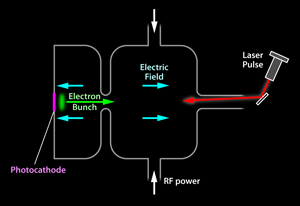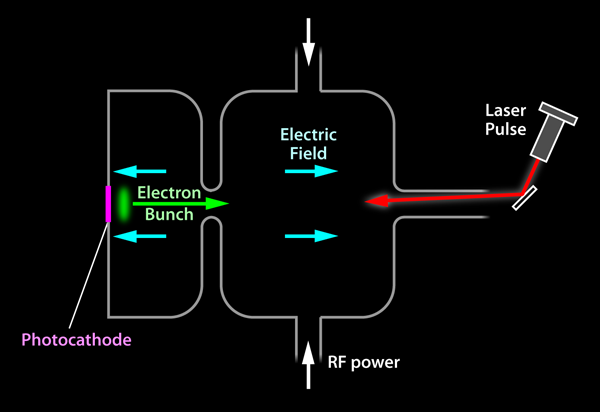Attention to Nanoscale Detail Leads to Brighter e-Beams
Electron linear accelerators (linacs) used for the most demanding applications—x-ray free-electron lasers (FELs) and linear colliders—must deliver beams with high brightness. In such a beam, many electrons with a narrow spread of energies are bunched into a short pulse, resulting in a high peak current. Along each of the two axes transverse to the beam’s direction, the emittance, essentially the product of the size and the angular spread, must be small. The low transverse emittances allow the beam to be brought to a tight focus, while the high peak current enables coherent emission in an FEL or a high collision rate in a collider. Focusing a low-emittance beam might be compared to aiming the spray from a garden hose while sticking your thumb in the end.
Electron guns produce the brightest beams by striking a photoemitting surface, called a photocathode, with a fast laser pulse (Fig. 1). As we’ve known since Einstein explained the photoelectric effect [1], to eject electrons from the surface, the energy of the laser photons must exceed the work function of the material, which is typically in the ultraviolet (UV) range for metals. But fast lasers produce light in the infrared (IR), and converting IR to UV is inefficient. The thermal properties of laser materials ultimately limit the number of electron bunches per second. In Physical Review Letters, Aleksandr Polyakov, of Lawrence Berkeley National Laboratory in California, and colleagues demonstrate efficient photoemission using IR on a metal surface patterned with parallel grooves nanometers (nm) apart [2]. In a related paper, Renkai Li of the University of California, Los Angeles, and colleagues demonstrate that a metal surface with another nanostructure—an array of nanoholes—produces a high-quality beam in a real photocathode electron gun [3]. Improving the efficiency of the conversion of laser energy into photoelectrons may lead to guns with a far higher pulse repetition rate, going from typically hertz (Hz) now, to several kilohertz. A higher rate means more data for users. An x-ray FEL could be more like a synchrotron light source, with many users sharing a facility and making measurements at their most efficient rate.
The brightness as the beam is born in the gun is critical, because Liouville’s theorem [4,5] tells us that its normalized brightness is conserved during drift, focusing, and acceleration. At the inception of this technology, electron guns used thermionic emission from a hot surface, like the filament of a vacuum tube or television CRT. Electrons leaving the cathode would spread out rapidly due to mutual repulsion (space charge) and the spread in their thermal energies. The next step for accelerator guns was to put a hot “button” of thermionic material inside a microwave [radio frequency (rf)] cavity with a strong longitudinal (axial) electric field that immediately redirects and accelerates the electrons before they spread. But since the sinusoidal field pulls electrons from the surface over degrees of phase, thermionic electron beams have a large energy spread and long bunches. Also, the emittance growth from space charge can be reduced by adjusting the distribution of emission across the surface of a cathode, but a simple hot surface does not offer this flexibility.
In contrast, a fast ( picosecond) laser pulse, with an intensity shaped in cross section and in time as it hits the photocathode, allows precise sculpting of the emission. Ideally, the cathode material should have a comparably fast response, reflect little of the incoming light, and have a high quantum efficiency (QE), which is the probability of emitting an electron for each absorbed photon. These qualities must last over a long lifetime in a reasonably high vacuum ( nanotorr). The photocathode must also withstand damage from the high rf field megavolts per meter (MV/m)] inside the resonant cavity. Most of these requirements are simply satisfied by aiming the laser at the cavity wall, so that it also serves as the photoemitter (see Fig. 1). The cavity must be made from a good conductor like copper. However, copper has a work function of electronvolts, requiring UV photons with a wavelength , and its QE is miserly, no more than , even for a smooth, clean surface.
These material properties constrain the gun’s repetition rate. For example, the Linac Coherent Light Source [6], which is the x-ray FEL at SLAC National Accelerator Laboratory, operates with bunch charges from to picocoulombs (pC). Ideally, microjoules ( ) of UV yields from the copper photocathode. This modest-sounding energy grows step by step as we work backward through the inefficiencies of each stage of a complex titanium-sapphire laser system. With adequate margins for higher charge and lower QE, and with strong requirements for stability and reproducibility, laser technology must be pushed to reliably run LCLS at .
It is possible to use the IR directly on a photocathode, using a multiphoton process to overcome the work function (for example, with photons for copper or for gold). However, the laser intensity (power/area) must be high, since multiphoton emission scales with . Moreover, metals are highly reflective ( ) in the IR, but only the absorbed energy contributes to emission. This does not offer an efficient alternative.
Polyakov et al. show that this comparison changes if the emitting area of the photocathode is covered with a carefully tailored subwavelength pattern that couples light to surface plasmons—oscillations of the unbound electrons in the metal surface. Photoemission gains in three ways: First, of the IR laser energy is no longer wasted through harmonic generation. Second, IR absorption climbs by an order of magnitude to nearly over a substantial bandwidth and a large range of incident angles. Finally, the pattern localizes strong fields and so enhances the nonlinear emission.
A further enhancement comes from operating in the “blowout regime” [7], in which the laser pulse is short duration femtoseconds (fs)] and flat (radius ), and has a circular intensity distribution . The resulting “pancake” electron bunch evolves under space-charge forces into a uniformly charged ellipsoid. It is far easier to fashion a laser pulse to produce this distribution in the IR, without worrying about distortions from harmonic generation. A substantial benefit also comes from nonlinearity: for constant laser energy, the intensity increases with , and so the emission grows with .
Polyakov et al. test a complex nanostructure of gold-plated grooves in aluminum, imaging the photoemission pattern in an electron microscope and measuring the photoemission current arriving on the walls of a vacuum chamber. Li et al. next show that a simpler structure of nanoholes on the copper wall of a standard rf photocathode gun offers a similar enhancement, with low reflection, a substantial gain in emission, and no sign of damage afterward. There is room for improvement. First, the bandwidth of the nanohole pattern’s reflection minimum is a little narrow for a - laser pulse, and so only of the laser light was absorbed. Second, Li et al. lower the usual rf field of their gun from to for their test. Also, the intrinsic (low-charge) emittance was found to be twice that of a flat cathode. However, this is quite a success for a first test. The authors project that with the usual field in the gun, this cathode could generate a - bunch using of IR in a - pulse. From the numbers given earlier, we see that a conventional flat copper cathode needs the same , but in the UV, to produce .
Over the past 30 years, FELs have evolved from IR demonstration experiments to the first hard x-ray FEL, LCLS, in 2009. An essential aspect of this progress has been the production of brighter electron beams, thanks to parallel improvements in rf photocathode guns and the lasers that drive them. Adding surface plasmons to the photocathode toolkit could enable new and creative developments in facilities for high-intensity femtosecond pulses of coherent x rays.
References
- A. Einstein, “Über einen die Erzeugung und Verwandlung des Lichtes betreffenden heuristischen Gesichtspunkt,” Ann. Phys. 322, 132 (1905)
- A. Polyakov, C. Senft, K. F. Thompson, J. Feng, S. Cabrini, P. J. Schuck, H. A. Padmore, S. J. Peppernick, and W. P. Hess, “Plasmon-Enhanced Photocathode for High Brightness and High Repetition Rate X-Ray Sources,” Phys. Rev. Lett. 110, 076802 (2013)
- R. K. Li, H. To, G. Andonian, J. Feng, A. Polyakov, C. M. Scoby, K. Thompson, W. Wan, H. A. Padmore, and P. Musumeci, “Surface-Plasmon Resonance-Enhanced Multiphoton Emission of High-Brightness Electron Beams from a Nanostructured Copper Cathode,” Phys. Rev. Lett. 110, 074801 (2013)
- J. Liouville “Note sur la Théorie de la Variation des Constantes Arbitraires,” J. Math. Pures Appl. Ser. I 3, 342 (1838)
- H. Wiedemann, Particle Accelerator Physics: Basic principles and linear beam dynamics (Springer, Berlin, 1993)[Amazon][WorldCat]
- P. Emma et al., “First Lasing and Operation of an Angstrom-Wavelength Free Electron Laser,” Nature Photon. 4, 641 (2010)
- O. J. Luiten, S. B. van der Geer, M. J. de Loos, F. B. Kiewiet, and M. J. van der Wiel, “How to Realize Uniform Three-Dimensional Ellipsoidal Electron Bunches,” Phys. Rev. Lett. 93, 094802 (2004)





